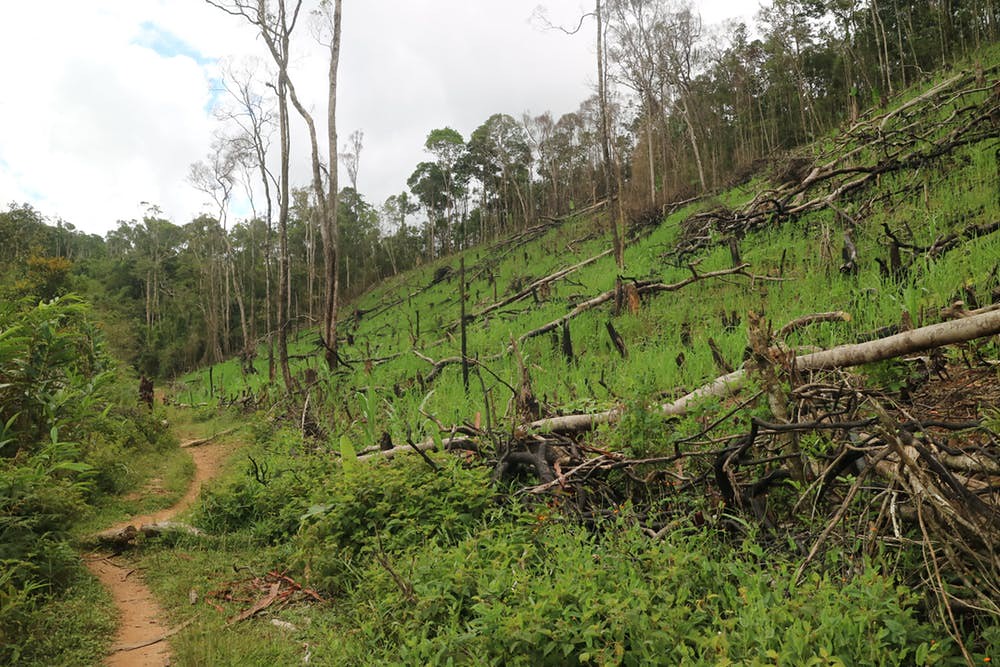紐約市立大學研究生中心的研究發現,若再不積極因應森林砍伐和人類引起的氣候變遷問題,兩者的綜合效應到了2070年可能使整個馬達加斯加東部的雨林消失,影響該島國特有的數千種植物、哺乳動物、爬行動物和兩棲動物。
該研究發表在當期《自然氣候變遷》(Nature Climate Change)期刊。研究指出,保護區有助於減輕破壞,而環境人士則致力於尋求長期解決方案,以解決溫室氣體排放失控和隨之而來的氣候變遷。
研究確立了應優先保護的完整森林區域,以加強受威脅物種的恢復能力和生存能力。

馬達加斯加位於印度洋,是僅次於澳洲的世界第二大島國,距東非海岸250英里(400公里)。由於與周邊各大洲長期處於隔離狀態,馬達加斯加有許多其他地方所沒有的動植物。
馬達加斯加是生物多樣性熱點,80%至90%的動植物物種為特有種,但數十年來的濫墾濫伐破壞了許多特殊和瀕危野生動物的棲地,包括瀕危的狐猴。
目前有兩種領狐猴瀕臨滅絕,牠們在生態系統中的角色是散播植物種子,而這些植物為雨林中的其他動物提供食物和庇護所。
研究主要作者、紐約市立大學研究生中心和亨特學院人類學教授巴登(Andrea Baden)博士說:「由於狐猴是重要的種子傳播者,對生活環境劣化也很敏感,因此牠是馬達加斯加整個東部雨林健康狀況的關鍵指標。」
非政府組織保護國際(Conservation International)認為,狐猴是馬達加斯加的代表性哺乳動物。在沒有猴子和其他競爭者的情況下,這些靈長類動物已經適應了當地遼闊的棲息地,並演化出許多不同的物種。
截至2012年,已正式確立103個狐猴的物種和亞種,其中有39種是動物學家在2000年至2008年間發現的。牠們幾乎都是稀有、易危或瀕危物種。自人類抵達馬達加斯加以來,至少有17種狐猴滅絕。
巴登博士和她的團隊在馬達加斯加研究兩種極度瀕危的領狐猴,利用長達三十年的研究資料,分析該國東部熱帶雨林面臨的威脅。
巴登說:「我們預測森林砍伐和氣候變遷的影響時,發現光是森林砍伐和氣候變遷兩個因素,就足以使狐猴棲息地減少50%以上。更令人震驚的是,這兩個因素到本世紀末將明顯減少熱帶雨林棲息地。」
研究人員的資料顯示,馬達加斯加東部雨林破壞的速度和強度將取決於該國是否制定嚴格的保護措施來防止毀林或因應鬆散的政策。
森林是狐猴的庇護所,也是連接牠們活動範圍的生態廊道。保護森林的工作非常重要,因為狐猴是當地的關鍵物種,在這個全球生物多樣性最豐富的地區,牠們的存續和許多其他動植物的存續息息相關。

馬達加斯加有許多特有哺乳動物,例如馬島獴(Fossa, Cryptoprocta ferox)。島上記錄到300多種鳥類,其中60%以上是特有種,還有全世界三分之二的變色龍物種,包括已知最小的一種。科學家認為。馬達加斯加可能是所有變色龍的起源地。
在馬達加斯加的14,883種植物中,有80%以上是特有種,包括五個植物科。島上許多原生植物物種被用作草藥。像長春花鹼和長春新鹼都是馬達加斯加長春花的生物鹼,用於治療霍奇金氏病、白血病和其他癌症。
巴登說:「我們的研究結果能幫助非營利組織、國家公園管理和更廣泛的狐猴群聚保育。結果顯示,森林覆蓋度和連結度是領狐猴和所有棲息於森林的野生動物生存的關鍵。保護區對於物種的生存至關重要。」
非營利組織已經在著手保護這個獨特而受威脅的地區。保護國際自1996年起就在馬達加斯加東部進行自然保育計畫。總部位於美國的「保護國際」正在協助馬達加斯加政府制定和實施「具有保育意識的永續發展策略」。
保護國際正在馬達加斯加東部的Ankeniheny-Zahamena廊道執行測試計畫,目的是產生碳信用額度,可以出售給想抵消碳排放量的公司或其他買家。這個計畫由外部審核方雨林聯盟(Rainforest Alliance)驗證,透過保護協議吸引社區參與、提供社區財政激勵措施,保護他們的森林並監測威脅。
世界野生動物基金會(WWF)在該地區也已經耕耘了三十多年,與當地社區合作保護馬達加斯加的獨特環境。
2020年是馬達加斯加脫離法國獨立60週年,將種下6000萬棵幼苗綠化馬達加斯加。在環境與永續發展部的邀請下,約有20個環境組織和多所大學的學生會參與這項公民活動。
環境與永續發展部植樹造林與景觀和森林管理總監傑克斯(Jaozandry Jean Jacques)表示,植樹造林活動將在2020年1月展開。
Left unchecked, the combined effects of deforestation and human-induced climate change could eliminate Madagascar’s entire eastern rainforest habitat by 2070, impacting thousands of plants, mammals, reptiles, and amphibians endemic to the island nation, finds new research from The Graduate Center at the City University of New York, CUNY.
Published in the current issue of the journal “Nature Climate Change,” the study also shows that protected areas will help to lessen the devastation while environmentalists work toward long-term solutions for ending runaway greenhouse gas emissions and the resulting climate change.
The study identifies areas of intact forest that could be prioritized for protection to enable resilience and survival of threatened species.
Madagascar, the world’s second-largest island country after Australia, lies in the Indian Ocean, 250 miles (400 kilometers) off the coast of East Africa. As a result of the island’s long isolation from neighboring continents, Madagascar is inhabited by animals and plants found nowhere else on Earth
It is a biodiversity hotspot where 80 to 90 percent of its animal and plant species are exclusive to the area, but the land has been devasted by decades of deforestation and overharvesting, destroying much of the land cover that provides habitat for unique animals, including endangered varieties of lemurs.
In particular, two species of ruffed lemurs are now critically endangered, and these animals play a central role in dispersing the seeds of plant species that provide food and shelter for other animals across the rainforest.
“Because of their essential role as seed dispersers and their sensitivity to habitat degradation, ruffed lemurs serve as a critical indicator of the health of Madagascar’s entire eastern rainforest,” said Dr. Andrea Baden, a professor of anthropology at The Graduate Center, CUNY and Hunter College and the study’s primary investigator.
Lemurs have been characterized as “Madagascar’s flagship mammal species” by Conservation International. In the absence of monkeys and other competitors, these primates have adapted to a wide range of habitats and diversified into numerous species.
As of 2012, there were officially 103 species and subspecies of lemur, 39 of which were described by zoologists between 2000 and 2008. They are almost all classified as rare, vulnerable, or endangered. At least 17 species of lemur have become extinct since humans arrived on Madagascar.
Dr. Baden and her team employed a case study of the two critically endangered ruffed lemurs using three decades of research throughout Madagascar to analyze threats to the country’s eastern tropical rainforest.
“When we projected the impact of deforestation and climate change, we found that deforestation alone and climate change alone could reduce ruffed lemur habitat by over 50 percent,” said Baden. “Even more alarming, these two factors together are projected to essentially decimate suitable rainforest habitat by the end of the century.”
The researchers’ data suggest that the speed and intensity of destruction to Madagascar’s eastern rainforest will be determined by whether the country institutes strict protections against deforestation or a relaxed set of policies.
Protecting forested areas that provide shelter to ruffed lemurs and serve as corridor links to their strongholds is particularly important to survival given their role as a keystone species that enables the survival of a large number of other animal and plant species in one of the world’s most biodiverse regions.
A number of other mammals, including the cat-like fossa, are endemic to Madagascar. Over 300 species of birds have been recorded on the island, of which over 60 percent are endemic. The island nation is inhabited by two-thirds of the world’s chameleon species, including the smallest known, and scientists have proposed that Madagascar may be the origin of all chameleons.
More than 80 percent of Madagascar’s 14,883 plant species are found nowhere else in the world, including five plant families. Many plant species native to the island are used as herbal remedies. The drugs vinblastine and vincristine are vinca alkaloids, used to treat Hodgkin’s disease, leukemia, and other cancers, were derived from the Madagascar periwinkle.
“The results from our study will be useful to nonprofit organizations, park management, and the broader conservation community,” Baden said. “Our results indicate potential conservation opportunities for ruffed lemurs and any of the rainforest-dwellers that rely on forest cover and connectivity. Protected areas are vital to species persistence.”
Nonprofit gorups are already at work protecting this unique and threatened area.
Conservation International has had conservation projects in eastern Madagascar since 1996. The nonprofit organization based in the United States is currently supporting the government of Madagascar in the development and implementation of “a conservation-conscious sustainable development strategy for the area.”
Conservation International has developed a pilot project in the Ankeniheny-Zahamena Corridor of eastern Madagascar that aims to generate carbon credits that can be sold to companies or other buyers looking to offset carbon emissions. Validated by an external auditor, the Rainforest Alliance, the project engages communities through conservation agreements that give these communities financial incentives to conserve their forests and monitor threats.
The World Wildlife Fund, WWF, has been active there for more than three decades, working with local communities to protect Madagascar’s unique environment.
For the 60th anniversary of Madagascar’s independence from France in 1960, 60 million young plants will be planted to green Madagascar.
In response to an invitation from the Ministry of the Environment and Sustainable Development, MEDD, some 20 environmental organizations and several university students are involved in this citizen mobilization.
Jaozandry Jean Jacques, director of Reforestation and Management of Landscapes and Forests within the MEDD, says, “We plan to officially open reforestation in Madagascar in January 2020.”
※ 全文及圖片詳見:ENS










